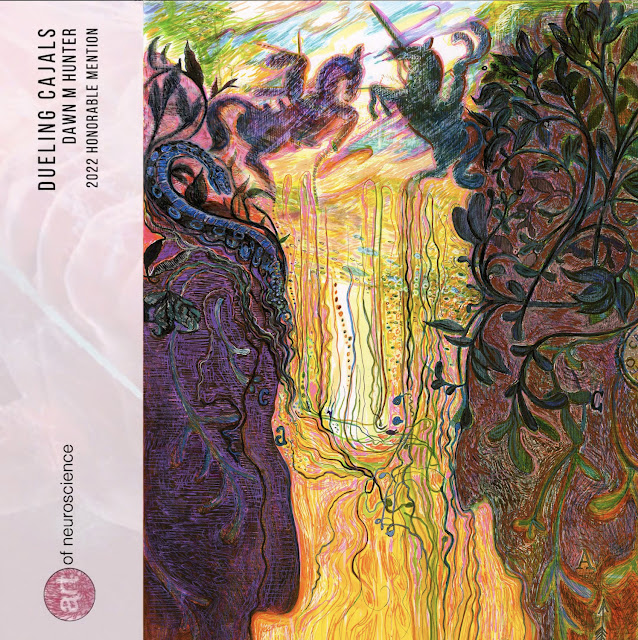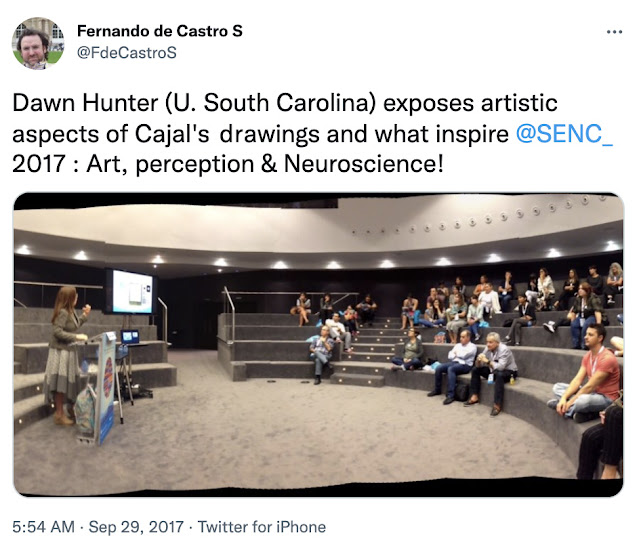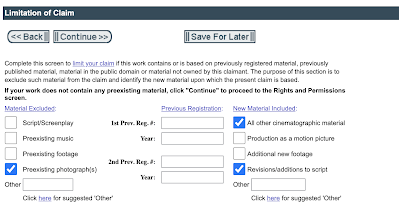What is in a name? A lot.
We live in a time of digital technology, and with the increasing use of artificial intelligence or bots by websites, confusion can be created, erroneous attributions can occur, and significant mistakes made.
My name is Dawn Hunter, and I have been a professional artist for over two decades and I have operated my website, www.dawnhunterart.com™, since the early aughts. This past year I have become aware of a website called “Wall of Celebrities” because they have posted eighteen of my original artworks and associated those artworks with an actress by the same name. In fact, there are more images of my artwork or me with my artwork than there are of the actress or her performances. This misattribution is significant, it compromises the authority of my work while simultaneously creating market and brand identity confusion for prospective exhibitors and collectors of my art.
Like anyone finding themselves in this predicament, I have notified the company of the erroneous attributions of artwork created by me but credited to another person. They promised to remove my artwork, and they have not. That was eight months ago, so I find the lack of action appalling. Additionally, they are offering free downloads of my artwork, Gasp! - without asking or receiving my permission.
My advice to my students and any young artist starting a professional practice is to copyright your artwork. If you find yourself in the same predicament, you will be able to pursue appropriate legal action. Which, of course, will be my next step.
In the meantime, to help eliminate confusion as to who created what, I am featuring my artworks (below) that are currently erroneously attributed to and associated with another person on the "Wall of Celebrities." I am also including a summary of their creation, links that verify the timeline history of the works and the professional exhibition history of those works. I have been very diligent over the years and recorded my creative and exhibition output on this blog and other social media outlets like Facebook and Flickr. All of this information can be seen publicly and the history of the creation and exhibition of my artwork can be traced. I have numbered (1-18) each image featured without my permission.
8/10/2022 Update:
Wall of Celebrities continues a copyright infringement of my artwork. They have taken down the artworks numbered 1, 2, 3, 6, 7 and 18 featured in this post. However they continue to display my artwork without my consent on the following links below.
Artworks numbered 4, 5, 8, 9, 10, 11, 12, 14, 15 and 17 are featured on this link:
https://www.wallofcelebrities.com/celebrities/dawn-hunter/landscape-photos-1.html
Artworks numbered 4, 5, 8, 10, 12, 13, 14 and 16 are featured on this link:
https://www.wallofcelebrities.com/celebrities/dawn-hunter/landscape-photos-2.html
1) Dawn Hunter, Portrait of Cajal from observation of Jorge Zockoll's oversized photograph at the Instituto Cajal, Madrid, marker and pen on paper,
11" x 14," 2017.
The work (#1 above) was also featured in an article about me by Aggie Mika in "The Scientist" magazine.
2) Dawn Hunter, Diana the Huntress, marker and pen on paper, 11" x 14," 2017.
3) Dawn Hunter, study of Cajal's Diencephalic Nuclei, marker and pen on paper,
11" x 14," 2017.
4) Dawn Hunter, drawing of NIH researcher Kenton Swartz's talk, marker and pen on paper, 11" x 14," 2017.
5) Artist Dawn Hunter with installation of the Cajal Inventory.
Here I am with my work while it was on display at the Instituto Cajal, 2017. For more information on the Cajal Inventory work, click here:
All of these images were originally featured on this blog after my participation in a collaborative symposium facilitated by the National Institutes of Health and the Instituto of Cajal, Madrid, Spain. Original post can be accessed here:
The works have gone on to be featured in national and international exhibitions, most recently at the college of Southern Nevada, Las Vegas, 2021. Images from exhibition featured below.
6) Dawn Hunter, Man as Sunflower, acrylic and graphite on paper, 14" x 17," 2014.
This work is currently on exhibition at the John Porter Neuroscience Research Center of the National Institutes of Health, alongside seven original scientific drawings created by Cajal. You can learn more about the show by clicking on the photos below.
Artist, Dawn Hunter and her daughter with the NIH exhibition, 2019.
Here I am with my daughter when we visited the show. The artwork Man as Sunflower is the closest work to the Cajal exhibition case. Man as Sunflower was also featured in a Jasper magazine article, see below.
Jasper Magazine Article featuring my artwork inspired by the life of
Santiago Ramón y Cajal.
Below is the link to the online copy of the Jasper Magazine article "The Artist and the Scientist," pp. 50-52, 2015. Use you right arrow on your keyboard to view the pages in the online publication.

7) Above is the detail from my painting Art Department. This is my most famous work from my Spectacle Spectacular series. It has toured in exhibitions internationally in the U.K. and Germany, and was a center piece work of the Kansas City Art Institute, Foundation 50th exhibition at the Leedy-Voulkos Art Center, 2015. The painting was also prominently featured in my solo exhibition at the Delaware Contemporary Art Center and appeared on the cover of the 86th issue of the College of Charleston's literary journal, Crazyhorse. The painting made its debut in the critically acclaimed, Day Job, 2010, exhibition, held at the Drawing Center, New York, NY. The artwork was also reviewed and featured in Artnet.
8) The creation of this painting, Blue Cerberus, has been well documented on this blog. I recorded the entire process through many posts. This work was featured in my solo exhibition at the Delaware Contemporary Art Center, 2014.
9) Dawn Hunter, detail of Blue Cerberus.
Below are two more works from my exhibition at the Delaware Contemporary Art Center:
10) Dawn Hunter, A Dream in August, graphite and ink on paper, 2014.
Exhibition image from the Delaware Contemporary Art Center.
11) Dawn Hunter, Dusk and Dawn with Horses, graphite and ink on paper, 18" x 24," 2014.
During my first sabbatical after I was awarded tenure at the University of South Carolina, I created a series titled: Personified Doubles and Complementary Opposites. The entire process of the series was well documented diaristtcally through a series of Facebook and Flickr posts.
To view the entire series on my personal website, click here. 12) Dawn Hunter, Vegas Garden, graphite, ink and acrylic on paper, 36" x 58,"2012.
13) Dawn Hunter, Secluded Play, graphite and ink on paper, 26" x 40," 2012.
Secluded Play continues fo garner critical attention, and the drawing was selected to be included in the juried exhibition, Simulacra, at the Sulfur Studios, Savannah, Georgia in 2021.
Read the entire article here:
14) Dawn Hunter, Magician's Garden, graphite and ink on paper, 30" x 40," 2012.
Both of the works #14 and #15 below were featured and the annual What's Love Fest.
Photos from the exhibition and link to the Facebook album about the event are below the images of the works.
15) Dawn Hunter, The Magician, graphite and ink on paper, 26" x 40," 2010.
16) Dawn Hunter, Birthday Cake, graphite and ink on paper, 26" x 40," 2010.
The Magician and Birthday Cake on exhibit at the What's Love Fest, 2010.
Artist, Dawn Hunter is featured in the center of this group photo.
Here I am with two UofSC Magellan Scholars that I mentored.
Dawn Hunter's artwork on exhibit at the What's Love Fest, The Magician and Birthday Cake were among five works that she exhibited. To learn more about the exhibition, click here.
Below is a work from my Spectacle Spectacular series, and it is from the portfolio series titled Spectacle Spectacular, Etcetera. This work was prominently featured in a SECAC members exhibition. To learn more about this work and the SECAC exhibition, click here.
17) Dawn Hunter, Bling Bling, Boobatopia, graphite and ink on paper, 72" x 80," 2007.
18) Dawn Hunter, Gold Rush, acrylic and gold leaf on canvas, 18" x 24," 2008.
The painting Gold Rush is from my Spectacle Spectacular series and is part of the Sitting Pretty installation which was exhibited at Rogue Community College, the UofSC Arts Institute, Mesquite Art Center and the University of Wisconsin, Madison.
I have also exhibited works from that series separately on under the individual titles of the work, like featured below. In that photo I am giving an artist's talk about the works at the Upstairs Artspace in Tryon, North Carolina.
Artist Dawn Hunter discusses her work with artist and, Line and Lies of the Face, exhibition curator, Margaret Curtis.
I had so much fun talking about my work at this show!
Exhibition announcement for the Lines and Lies of the Face.

Dawn Hunter, the evolving Sitting Pretty installation, viewers examining the work at an exhibition, eighteen works completed by 2008.
Dawn Hunter, detail of Sitting Pretty.

























































